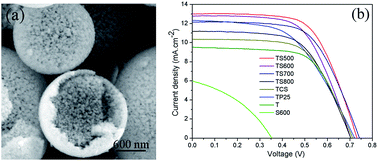A simple spray reaction synthesis and characterization of hierarchically porous SnO2 microspheres for an enhanced dye sensitized solar cell†
Abstract
This paper reports first on the novel synthesis of hierarchical tin dioxide (SnO2) porous microspheres in the absence of a template using a simple spray reaction technique and annealing at 500–800 °C. The SnO2 microspheres obtained are tetragonal phase and approximately 2.2–2.7 μm in diameter, and they consist of 6.7–23.1 nm crystallites and possess hierarchical pores and Brunauer–Emmett–Teller (BET) surface areas of up to 55 m2 g−1. Using ultraviolet-visible absorption spectra analysis, it is found that SnO2 crystallites demonstrate a quantum size effect, resulting in a widening of the band gap of the SnO2 spheres. This band gap can be tuned from 3.99 eV (800 °C) to 4.26 eV (600 °C) by varying the annealing temperature. Using separated SnO2 porous spheres as the scattering layer of the photoanode for dye sensitized solar cells (DSSCs), the solar light-electricity conversion efficiency (maximum: 6.0%) is increased by up to 31.9% and 28.2% compared to cells using a commercial SnO2 powder and P25 nanopowder as the scattering layers, respectively, under the same conditions.



 Please wait while we load your content...
Please wait while we load your content...